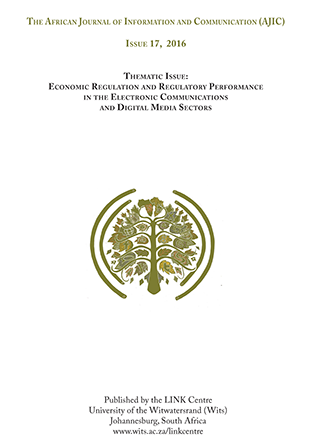The "Evolution" of Regulation in Uganda’s Mobile Money Sector
DOI:
https://doi.org/10.23962/10539/21627Keywords:
mobile money, regulation, competition policyAbstract
Uganda's mobile money sector has grown rapidly since its introduction in 2009. As at the last quarter of 2015, there were 21.1 million registered mobile money users in the country, representing a penetration of about 54%. As well as providing a convenient, cheap and safe means of money transfer, mobile money has spurred increased financial inclusion, which grew from 28% in 2009 to 54% in 2013. The rapid growth has happened under conditions of "light touch" regulation of the sector, which allows the first mover to reap the rewards of investments made, but raises potential competition issues. The mobile money sector, much like the telecommunications sector, is characterised by network externalities, lock-in effects and high barriers to entry that can give rise to a concentrated sector with a single dominant player. This article considers the effect of light touch regulation on the competitive dynamics in the mobile money market in Uganda and contrasts this with the experience in Tanzania, where regulation evolved from a light touch style to a more comprehensive framework as the sector grew.
References
Armstrong, M. (2006). Competition in two-sided markets. The RAND Journal of Economics, 37(3), 668-691. https://doi.org/10.1111/j.1756-2171.2006.tb00037.x
Banda, F., Robb, G., Roberts, S., & Vilakazi, T. (2015). Review paper one: Key debates in competition, capabilities development and related policies: Drawing the link between barriers to entry and inclusive growth. CCRED Working Paper No. 4/2015. Centre for Competition, Regulation and Economic Development, University of Johannesburg. https://doi.org/10.2139/ssrn.2716038
Blechman, J. G. (2016). Mobile credit in Kenya and Tanzania: Emerging regulatory challenges in consumer protection, credit reporting and use of customer transactional data.
Bank of Uganda (BoU). (2013). Mobile money guidelines. Retrieved from https://www.bou.or.ug
Bank of Uganda (BoU). (2015). Annual supervision report: Issue No. 6. Retrieved from https://www.bou.or.ug
Bourreau, M., & Valletti, T. (2015). Enabling digital financial inclusion through improvements in competition and interoperability: What works and what doesn’t? CGD Policy Paper 065. Washington, DC: Center for Global Development (CGD). Retrieved from http://www.cgdev.org/publication/enabling-digital-financial-inclusion-through-improve-ments-competition-and
Cartesian. (2015). Mobile platform access for USSD-based applications (MPA-USSD): Market assessment. Prepared for Uganda Communications Commission (UCC). Retrieved from http://www.ucc.co.ug/files/downloads/SMP_Report_Mobile_Platform_Ac-cess_USSD_April%202015.pdf
Dignited. (2016, August 16). MTN Mokash: 10 things you need to know about Mokash micro savings and loans. Retrieved from http://www.dignited.com/20282/mtn-mokash-10-things-need-know-mokash-micro-savings-loans/
Economic Policy Research Centre (EPRC). (2013). Unlocking barriers to f inancial inclusion. FinScope III survey report findings. Kampala: Makerere University. Retrieved from http://www.eprcug.org/research/finscope-iii-survey
Evans, D., & Pirchio, A. (2015). An empirical examination of why mobile money schemes ignite in some developing countries but flounder in most. Coase-Sandor Institute for Law and Economics Working Paper, 723. The University of Chicago Law School. https://doi.org/10.2139/ssrn.2578312
EzeeMoney (U) Limited v. MTN Uganda Limited, Civil Suit No. 330 of 2013, High Court of Uganda at Kampala [Commercial Court], (2015). Retrieved from http://www.ulii.org/ug/Ezeemoney%20(U)%20Ltd%20Vs%20MTN%20(U)%20Ltd_1.docx
Farrell, J., & Klemperer, P. (2007). Coordination and lock-in: Competition with switching costs and network effects. In M. Armstrong, & R. Porter (Eds.), Handbook of industrial organization: Volume 3, (1970-2072). https://doi.org/10.1016/S1573-448X(06)03031-7
Financial Inclusion Insights (FII). (2014). Digital pathways to financial inclusion: Findings from the nationally representative FII tracker survey in Uganda (wave 1), focus group discussions with lapsed users and nonusers of mobile money, and mobile money agent research. Final Report. Retrieved from http://finclusion.org/uploads/file/re-ports/FII-Uganda-Wave-One-Wave-Report.pdf
Ggombe, K. M. (2014). Mobile money, remittances and rural household welfare: Panel evidence from Uganda. GRIPS Discussion Paper No. 14-22. Tokyo: National Graduate Institute for Policy Studies (GRIPS). Retrieved from http://www.grips.ac.jp/r-center/wp-content/uploads/14-22.pdf
Hernandez, J., Bernstein, J., & Zirkle, A. (2011). The regulatory landscape for mobile banking. GSR11 Discussion Paper. Geneva: International Telecommunication Union (ITU). Retrieved from https://www.itu.int/ITU-D/treg/Events/Seminars/GSR/GSR11/.../04-M-Banking-E.pdf
Katz, M. L., & Shapiro, C. (1985). Network externalities, competition and compatibility. The American Economic Review, 75(3), 424-440. Retrieved from https://www.jstor.org/stable/1814809
Macmillan, R. (2016). Digital financial services: Regulating for financial inclusion. GSR16 Discussion Paper. Geneva: International Telecommunication Union (ITU). Retrieved from https://www.itu.int/en/ITU-D/Conferences/GSR/Documents/GSR2016/Digital_financial_inclusion_GDDFI.pdf
Mazer, R., & Rowan, P. (2016). Competition in mobile financial services: Lessons from Kenya and Tanzania. Washington, DC: Consultative Group to Assist the Poor (CGAP). Retrieved from http://www.cgap.org/sites/default/files/Working-Paper-Competi-tion-in-MFS-Kenya-Tanzania-Jan-2016.pdf
McGrath, F., & Lonie, S. (2013). Platforms for successful mobile money services. GSMA Mobile Money for the Unbanked. Retrieved from http://www.gsma.com/mobilefordevel-opment/platforms-for-successful-mobile-money-services
MTN Uganda. (n.d.). Mobile money tariffs. Retrieved from https://www.mtn.co.ug/Mo-bile%20Money/How%20to%20use/Pages/Mobile-Money-Tariffs.aspx
MTN Uganda. (2015). MTN Uganda is the leading financial services provider with its mobile money offering. [Media release.] Retrieved from http://www.mtn.co.ug/new-Paremoerworld/press-releases/Documents/2015/October/Mobile%20Money%20Themat-ic%20-%20Press%20Release.pdf
Muhumuza, M. K. (2016, January 11). How amended financial law could revolutionise banking. Daily Monitor. Retrieved from http://www.monitor.co.ug/Business/How-amend-ed-financial-law-could-revolutionise-banking/688322-3027954-14dep4fz/index.html
Ochieng’, L. (2014, July 27). CAK orders Safaricom to open up M-Pesa. Daily Nation. Retrieved from http://www.nation.co.ke/business/CAK-orders-Safaricom-to-open-up-M-Pesa/-/996/2399632/-/69n55oz/-/index.html
Ochwo, A. (2016, August 12). MTN, CBA Bank launch MoKash. The Observer. Retrieved from http://allafrica.com/stories/201608120543.html
Okwii, D. (2015a, March 9). Almost everyone agrees, Airtel Uganda is leading the mobile money innovation train. Dignited. Retrieved from http://www.dignited.com/12624/airtel-uganda-is-leading-the-mobile-money-uganda-innovation-train/
Okwii, D. (2015b, January 12). 5 companies changing mobile money transfer and payment systems in Uganda. Dignited. Retrieved from http://www.dignited.com/11675/5-com-panies-changing-mobile-money-transfer-payment-systems-uganda/
Republic of Uganda. (2013). The Uganda Communications Act, No. 1 of 2013. The Uganda Gazette No. 4, Volume CVI. Retrieved from https://www.ict.go.ug/sites/default/files/Resource/UCC%20Act%202013.pdf
Roberts, S., Blechman, J., & Odhiambo, F. (2016). A comparative study of competition dynamics in mobile money markets across Tanzania, Uganda and Zimbabwe: Tanzania Country Paper. Johannesburg: Centre for Competition, Regulation and Economic Development (CCRED), University of Johannesburg.
Roberts, S., Macmillan, R., & Lloyd, K. (2016). A comparative study of competition dynamics in mobile money markets across Tanzania, Uganda and Zimbabwe: Synthesis report. Johannesburg: Centre for Competition, Regulation and Economic Development (CCRED), University of Johannesburg
Rohlfs, J. (1974). A theory of interdependent demand for a telecommunications service. Bell Journal of Economics and Management Science, 5, 16-37. https://doi.org/10.2307/3003090
Rysman, M. (2009). The economics of two-sided markets. Journal of Economic Perspectives, 23(3), 1. https://doi.org/10.1257/jep.23.3.125
Downloads
Published
Issue
Section
License
Copyright (c) 2016 https://creativecommons.org/licenses/by/4.0

This work is licensed under a Creative Commons Attribution 4.0 International License.
How to Cite
- Abstract 282
- pdf 581


.png)